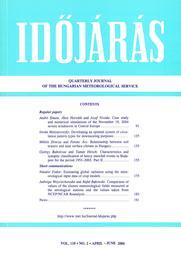Időjárás - Quarterly Journal of the Hungarian Meteorological Service (OMSZ)
Vol. 110, No. 2 * Pages 91–192 * April - June 2006
 |
|
 download [pdf: 44867 KB]
download [pdf: 44867 KB]
Case study and numerical simulations of the November 19, 2004 severe windstorm in Central Europe
Simon André, Horváth Ákos, Vivoda, J.
idojaras.2006.2.1 (p. 91–)
Simon André, Horváth Ákos, Vivoda, J.
idojaras.2006.2.1 (p. 91–)
Developing an optimal system of circulation pattern types for downscaling purposes
Matyasovszky István
idojaras.2006.2.2 (p. 125–)
Matyasovszky István
idojaras.2006.2.2 (p. 125–)
Relationship between soil texture and near surface climate in Hungary
Drucza Miklós, Ács Ferenc
idojaras.2006.2.3 (p. 135–)
Drucza Miklós, Ács Ferenc
idojaras.2006.2.3 (p. 135–)
Characteristics and synoptic classification of heavy snowfall events in Budapest for the period 1953–2003 Part II
Hirsch Tamás, Babolcsai György
idojaras.2006.2.4 (p. 155–)
Hirsch Tamás, Babolcsai György
idojaras.2006.2.4 (p. 155–)
Estimating global radiation using the meteorological input data of crop models
Fodor Nándor
idojaras.2006.2.5 (p. 175–)
Fodor Nándor
idojaras.2006.2.5 (p. 175–)
Comparison of values of the chosen meteorological fields measured at the aerological stations and the values taken from NCEP/NCAR Reanalysis
Woyciechowska, J., Bqkowski, R.
idojaras.2006.2.6 (p. 183–)
Woyciechowska, J., Bqkowski, R.
idojaras.2006.2.6 (p. 183–)
IDŐJÁRÁS - Quarterly Journal

Az IDŐJÁRÁS a HungaroMet Nonprofit Zrt. negyedévenként megjelenő angol nyelvű folyóirata
Megrendelhető a journal.idojaras@met.hu címen.
A szerzőknek szánt útmutató itt olvasható.
Megrendelhető a journal.idojaras@met.hu címen.
A szerzőknek szánt útmutató itt olvasható.









